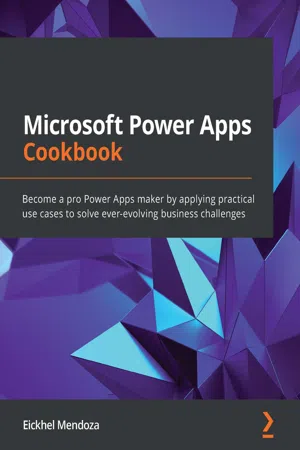
Microsoft Power Apps Cookbook
Become a pro Power Apps maker by applying practical use cases to solve ever-evolving business challenges
- 376 pages
- English
- ePUB (mobile friendly)
- Available on iOS & Android
Microsoft Power Apps Cookbook
Become a pro Power Apps maker by applying practical use cases to solve ever-evolving business challenges
About this book
Find our new updated edition to get the latest industry knowledge at your disposal
Key Features
Book Description
Microsoft Power Apps Cookbook is a complete resource filled with meticulously crafted recipes to help you build customized business apps that meet ever-changing enterprise demands. You will learn how to design modern apps with the low-code approach in a rapid application development environment by achieving enterprise-wide business agility.
What you will learn
- Learn to integrate and test canvas apps
- Design model-driven solutions using various features of Microsoft Dataverse
- Automate business processes such as triggered events, status change notifications, and approval systems with Power Automate
- Implement RPA technologies with Power Automate
- Extend your platform using maps and mixed reality
- Implement AI Builder s intelligent capabilities in your solutions
- Extend your business applications capabilities using Power Apps Component Framework
- Create website experiences for users beyond the organization with Microsoft Power Pages
Who this book is for
This book is for citizen developers and business users looking to build custom applications as per their organizational needs without depending on professional developers. Traditional app developers will also find this book useful by discovering how to build applications in a rapid application development environment with increased productivity and speed. The book is recommended for Power Apps beginners who have taken a couple of online tutorials but are struggling to implement or create real-world solutions. Basic knowledge of Power Apps is necessary to get the best out of this cookbook.
]]>
Frequently asked questions
- Essential is ideal for learners and professionals who enjoy exploring a wide range of subjects. Access the Essential Library with 800,000+ trusted titles and best-sellers across business, personal growth, and the humanities. Includes unlimited reading time and Standard Read Aloud voice.
- Complete: Perfect for advanced learners and researchers needing full, unrestricted access. Unlock 1.4M+ books across hundreds of subjects, including academic and specialized titles. The Complete Plan also includes advanced features like Premium Read Aloud and Research Assistant.
Please note we cannot support devices running on iOS 13 and Android 7 or earlier. Learn more about using the app.
Information
Chapter 1: Building pixel-perfect solutions with Canvas Power Apps
- Discovering best practices when building canvas apps
- Creating an incident tracking solution – Setting up the data source
- Creating an incident tracking solution – Building the user interface
- Embedding an expense tracking list with SharePoint list Power Apps
- Creating a Power App from existing data
Discovering best practices when building canvas apps
Variable naming
Control usage
- Having a great-looking app using many controls to build its user interface but hurting performance each time the screens get rendered.
- Displaying data to the user using a gallery inside a gallery. This approach might be tempting to present master-detail data, but this would be a significant slowdown in your application.
Coding methodology
- If you have data that rarely changes, you can create collections on application start to avoid round-trips each time data is required. Even more, if you have data that never changes, you can import this as static data inside your app for speedier access.
- Taking advantage of the features available in your data source can significantly improve your application building process and even its performance. For example, when using Dataverse or a relational database, there is a significant difference when querying data if you use a data source view instead of building the actual query in your application logic, especially if it needs complex relationships. Using these views gives you cleaner code while also improving performance. This improvement relays on the data source engine as it is the one that executes the data processing instead of the Power App.
Table of contents
- Why subscribe?
- Contributors
- Preface
- Chapter 1: Building pixel-perfect solutions with Canvas Power Apps
- Chapter 2: Building from data with model-driven apps
- Chapter 3: Choosing the right data source for your applications
- Chapter 4: Automating processes with Power Automate
- Chapter 5: Extending the Platform
- Chapter 6: Improving User Experience
- Chapter 7: Power Apps Everywhere
- Chapter 8: Empowering your applications with no code Artificial Intelligence
- Chapter 9: Discovering the Power Platform admin center
- Chapter 10: Tips, Tricks, and Troubleshooting
- Chapter 11: Advanced Techniques with Power Apps Component Framework
- Other Books You May Enjoy